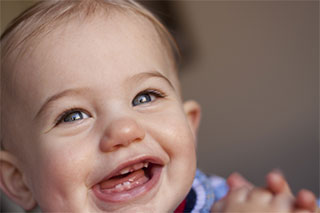 What are the dental milestones your child should meet? You've read about when your child should walk, talk, and meet other common milestones. But what about the markers of oral development? If you want to learn more about how your child's teeth will change over their first few years, look at parents’ top questions about dental milestones answered.
What are the dental milestones your child should meet? You've read about when your child should walk, talk, and meet other common milestones. But what about the markers of oral development? If you want to learn more about how your child's teeth will change over their first few years, look at parents’ top questions about dental milestones answered.
When Should a Baby Get Their First Tooth?
According to the American Academy of Pediatric Dentistry (AAPD), most infants will get their first teeth sometime between six and 12 months of age. But this doesn't mean your baby can't get their first tooth before they turn six months or after their first birthday.
Your child is born with teeth—that is, teeth hiding under the gumline. Sometime during the first trimester of pregnancy (around six weeks), the primary substances teeth are made from forms, and by three to four months gestation the hard tissue that will surround the teeth will start to develop, according to Stanford Medicine Children's Health.
Which Teeth Are the First To Come In?
The American Dental Association (ADA) notes that the first baby teeth to erupt in a child's mouth are usually the lower central incisors (at six to 10 months). The upper central incisors typically break through the gums around eight to 12 months of age.
This is followed by the upper lateral incisors (nine to 13 months), the lower lateral incisors (10 to 16 months), the first upper molars (13 to 19 months), the first lower molars (14 to 18 months), the upper canines (16 to 22-months), the lower canines (17 to 23-months), the second lower molars (23 to 31-months), and the second upper molars (25 to 33-months).
Like the first tooth eruption, this pattern is only sometimes precise for every child. Your baby may not get every tooth in this exact order or the expected milestone month range. Genetics and health factors can affect when your child gets each tooth.
What Are The Next Dental Milestones?
After your child has all of their baby or primary teeth (20 in total), their mouth will continue to grow. Your child's jawbone is forming during this time, and they are getting ready to shed their primary teeth to make room for their adult or permanent teeth.
The first permanent teeth to erupt are usually the lower central incisors and lower first molars (at six to seven years of age). According to the ADA, the first upper molars may erupt between ages six and seven. The upper central incisors may erupt between seven and eight years, and the lower lateral incisors may also come between seven and eight years of age. Between eight and nine years, the upper lateral incisor may begin to break through the gum.
At nine to 10 years of age, your child's lower canines may erupt. The first upper and lower premolars (bicuspids) may be between 10 and 12 years old. The upper second premolar may erupt between 10 and 12 years, while the lower could occur between 11 and 12 years. Expect to see upper second molars between ages 10 and 12. The lower second molars will wait until the tween years, between 11 and 13 years.
The last teeth to come in are the third molars. Also known as wisdom teeth, your child may never see these molars. The eruption process could begin between the ages of 17 and 21. But some wisdom teeth will stay trapped under the gumline. If your child has impacted wisdom teeth that can't or don't have space to erupt, they will need an extraction procedure. This oral surgery removes the wisdom teeth and can reduce the effects of overcrowding (such as misalignment).
When Will Your Child Need Orthodonture?
This is a common dental development question that many parents have. Whether you had braces, a retainer, or another orthodontic device in your younger years, you may wonder when your child will need the same treatment. There is no orthodonture milestone that every child meets at the same time. Some children will never need this treatment, while others may need extensive care.
Start the orthodontic journey with your child's regular pediatric dentist. The dentist knows your child, their dental history, and their family history. Some orthodontic treatments are better suited to younger children.
A palette expander is one example of a dental device that may work better for a younger child (compared to a teen or an adult). This device helps to widen the jaw, creating more space for your child's teeth.
Like wisdom tooth removal, this decreases the risks of overcrowding and misalignment. According to the Cleveland Clinic, many dental professionals recommend palate expanders for children at or around ages seven and eight—before the jawbones have completely formed.
Does your child need their first dental cleaning, a checkup, or a specialized dental service? Contact Dentistry For Children and Adolescents for more information.